History
In 1939 Fokker had developed an (all-metal) successor of the Douglas DC-2 and DC-3, the Fokker F.24. KLM had ordered four examples and at the time of the German invasion was the first one was under construction.
During the war, the development was secretly continued and in December 1945 Fokker proposed a number of aircraft types that they wanted to develop, including an all-metal airliner.
In autumn 1949 Fokker received subsidy from the Nederlands Instituut voor Vliegtuigontwikkeling, NIV (Dutch Institute for Aerospace Programmes) for a feasibility study on a passenger aircraft with jet engines or turboprops.
In 1951, the first models of the new aircraft were tested in the wind tunnel and in 1953 the final form was established. The same year it was also the first time the new airliner was shown to the public at the Paris Salon Aeronautique .
Two flying prototypes, internally referred to as F.1 and F.3 and two static prototypes, referred to as F.2 and F.4 were built.
On November 24, 1955 the F.1 made its maiden flight. The aircraft, registered as PH-NIV, was equipped with two Rolls Royce Dart RDa6 507 of 1540 hp each, each driving a propeller with a diameter of 3,05 m.
Later these engines were replaced with two Rolls Royce Dart RDa 6 511 of 1740 hp each and driving propellers with a diameter of 3,57 m, as would be applied to the production version, the Fokker F.27 series 100.
In 1957 the engines were replaced by two Rolls Royce Dart 7 RDa 528 of 1835 hp each, as would be applied to the F.27. 200 series
In June 1961, the last flight was made and the unit was eventually dismantled.
Fairchild had acquired the license rights but wanted a version for 32 to 36 passengers, four more than the original version, which could take 28 to 32 passengers.
The second flying prototype, F.3, registered as PH-NVF, had a longer fuselage; This was made 91 cm longer in front of the wing and the fuselage length was therefore 23,16 m. The aircraft had two Rolls Royce engines RDa 6 511-7E of 1742 hp each driving a a propeller of 3,66 m diameter.
The F.3 was widely used for demonstration flights, especially for long flights two additional wing tanks were fitted.
Versions.
Often the "Mark" designation instead of 'series' was used for the several subtypes, for example Fokker F.27 series 100 was then known as Fokker F.27 Mark 100 (or Mk. 100).
The Fokker built aircraft were designated F.27. They were usually equipped with English instruments.
The Fairchild built aircraft were designated F-27 and had American instruments.
Both types seemed not to differ much, but most parts were not interchangeable.
- Fokker F.27 series 100:
- the original type, with 44 seats; propeller with rounded tips; 84 examples built.
- Fokker F.27 series 100MPA: prototype of F.27 MPA, a modified F.27 series 100.
- Fokker F.27 series 200:
- identical to series 100 but equipped wit two Rolls Royce Dart Mk 802 engines; 115 examples built.
- Fokker F.27 series 200M Maritime: Maritime patrol version; Fifteen examples built.
The type could carry two external fuel tanks of 900 l each. In the right tank a remote controlled searchlight was added.
There were convex windows just behind the wings and on each side of the cockpit.
Furthermore, additional fuel tanks of 1000 litres each were installed in the wings. Under the fuselage a radome with a search radar was present, and also there was search equipment contained in a tube under the fuselage.
For positioning an inert navigation device was present.
The type proofed to be a very stable platform with a flight endurance of 11 hours.
- Fokker F.27 series 200M Maritime: Maritime patrol version; Fifteen examples built.
- Fokker F.27 series 300 Combiplane:
- Three examples of a freight version of the series 100, with left in the front of the fuselage a door of 2,32 x 1,78 m.
- Fokker F.27 series 300M "Troopship": Nine examples built for RNlAF equal to F.27 series 300 with two additional wide passenger doors on both sides of the fuselage .
- Fokker F.27 series 400 "Combiplane":
- freight version of series 200 with a door of 2,32 x 1,78 m ; equipped with more powerful Rolls Royce Dart12 engines Eighteen examples built.
- Fokker F.27 series 400M "Maritime": maritime patrol version of series 400, equal to 200M; two examples built.
- Fokker F.27 series 500:
- extended (with 1,50 m) version based on series 400, with 52 seats. 124 examples built..
- Fokker F.27 series 600:
- Reinforced 400 series with more powerful engines; higher payload and takeoff weight; 132 examples built.
- Fokker F.27-600RF: initially designated as F.27 series 800, with reinforced undercarriage for rough terrain.
- Fokker F.27 series 700:
- Two examples of series 100 with large freight door, but no reinforced floor.
- Fairchild F-27:
- first production version. First (commercial) flight July 1958; 47 examples built.
- Fairchild F-27A:
- identical to Fokker F.27 series 200; 42 examples built.
- Fairchild F-27F: VIP version based on F-27A; twenty examples built.
- Fairchild F-27J: F-27A with more powerful Rolls Royce RDa.10 Dart 540-7 of 2305 hp each, driving a four bladed propeller of 3,81 m diameter. Fourteen examples built.
- Fairchild F-27M:One example based on F-27J for use at higher altitudes equipped with larger propellers.
- Fairchild F-27B:
- similar to Fokker F.27 series 300; three examples built..
- Fairchild FH-227:
- F-27J with extended fuselage (2 m in front of the wing) an two Rolls Royce RDa7 Dart 532-7 engines. 28 examples built; twelfth example with reinforced wings.
- Fairchild FH-227B: modified FH-227 with modified fuselage, larger propellers and improved brakes. 37 examples built.
- Fairchild FH-227C:Five examples of an modified FH-227 with larger propellers as of FH-227B.
- Fairchild FH-227D:FH-227B with more powerful Rolls Royce RDA.7 Dart 532-7L engines and discs. Eight examples built.
- Fairchild FH-227E:(after delivery) modified FH-27 with Rolls Royce RDA.7 Dart 532-7L engines and discs.
| Dimensions: | |||
| Length: | 23,56 m | Wing span: | 29 m |
| Weights: | |||
| Height: | 8,5 m | Wing area: | - m2 |
| Empty weight: | 10247 kg | Max. start weight: | 18350 kg |
| Performance: | |||
| Cruising speed: | - km/hr | Max. speed: | 421 kmhr |
| Climbing speed: | - m/min | ||
| Service ceiling: | - m | Range: | 1715 km |
| Miscellaneous: | |||
| Engine type: | Two Rolls Royce Dart 6 MK.514-7 rated 1670 hp each | ||
| Crew: | - | ||
| Armament: | None | ||
| Length: | 23,56 m | Wing span: | 29 m |
| Height: | 8,7 m | Wing area: | - m2 |
| Weights: | |||
| Empty weight: | 10247 kg | Max. start weight: | 18350 kg |
| Performance: | |||
| Cruising speed: | - km/u | Max. speed: | 421 km/hr |
| Climbing speed: | - m/min | ||
| Service ceiling: | - m | Range: | 1715 km |
| Crew: | - | ||
| Engine type: | Two Rolls Royce Dart 6 MK.514-7 rated 1670 hp each | ||
| Armament: | None | ||
| Length: | 23,56 m | Wing span: | 29 m |
| Height: | 8,7 m | Wing area: | - m2 |
| Weights: | |||
| Empty weight: | 13725 kg | Max. start weight: | 17700 kg |
| Performance: | |||
| Cruising speed: | - km/u | Max. speed: | 463 km/hr |
| Climbing speed: | - m/min | ||
| Service ceiling: | - m | Range: | 5000 km |
| Crew: | |||
| Engine type: | Two Rolls Royce Dart Mk 552 rated 2330 hp each | ||
| Armament: | - | ||
| Notes: | MPA = maritime patrol version of the Fokker F-27 Mk.200. Originally equipped with two Rolls Royce Dart 511-7E engines rated 1600 hp (at the propeller) max. speed 410 km/hr; Range abt 2200 km. Equipped with radar |
||
Information about Dutch aircraft.

Fokker F.27 Mk.300M, C-8, photographed at airbase Soesterberg (scanned, old rather bad negative).
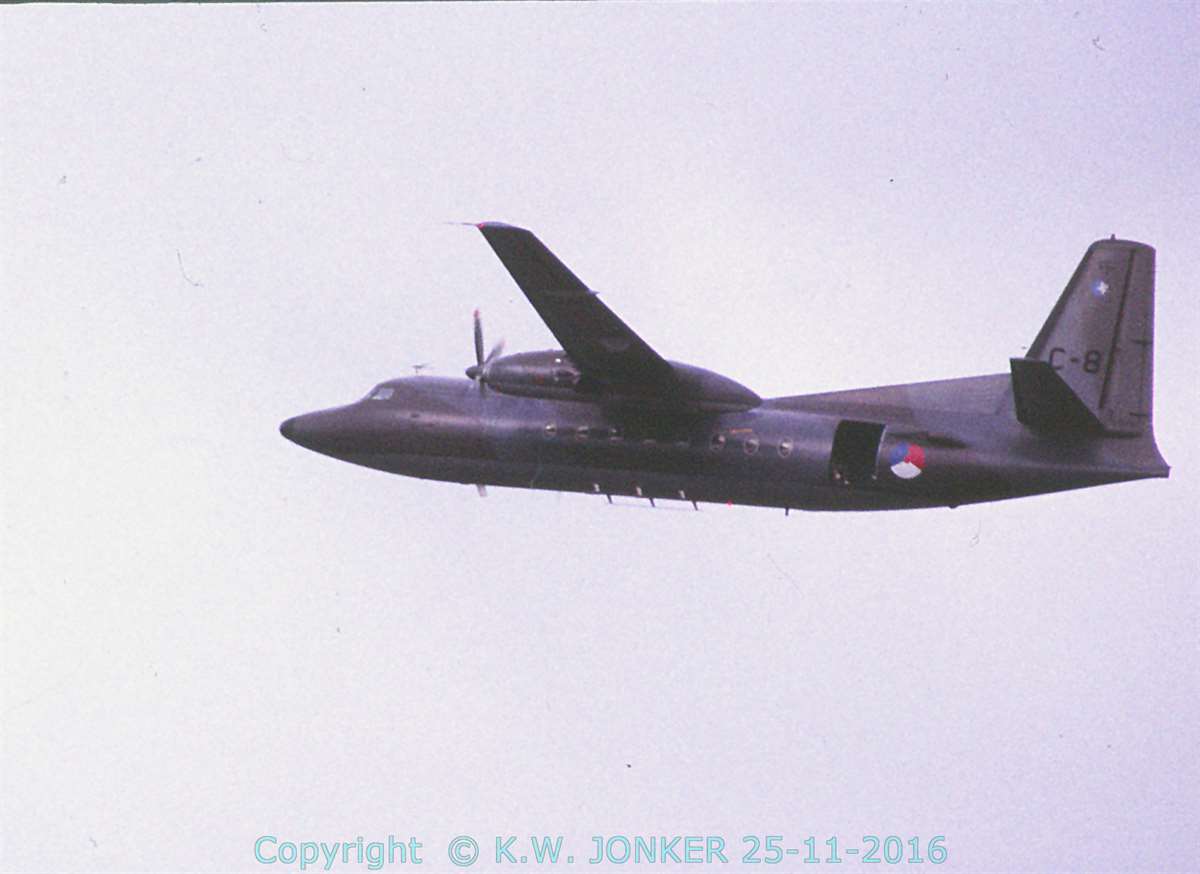
Fokker F.27 Mk 300M, C-8, with radar nose, photographed during the Open Day Dutch Air Force, September 1989 at airbase Volkel.
Fokker F.27M
During the 70s there arose operational problems with the Lockheed Neptune of the MLD. In particular, the availability of the special fuel F22 was very poor.
Because of this the detachment of the Neptune at Hato airfield was compromised.
In 1978 the Chief of the Naval Staff, Vice Admiral Veldkamp, received a commission to research the usefulness of the Fokker F.27M (Maritime).
The result of this study was that this type was well suited for the task in the Netherlands Antilles, only the lack of armament was a disadvantage.
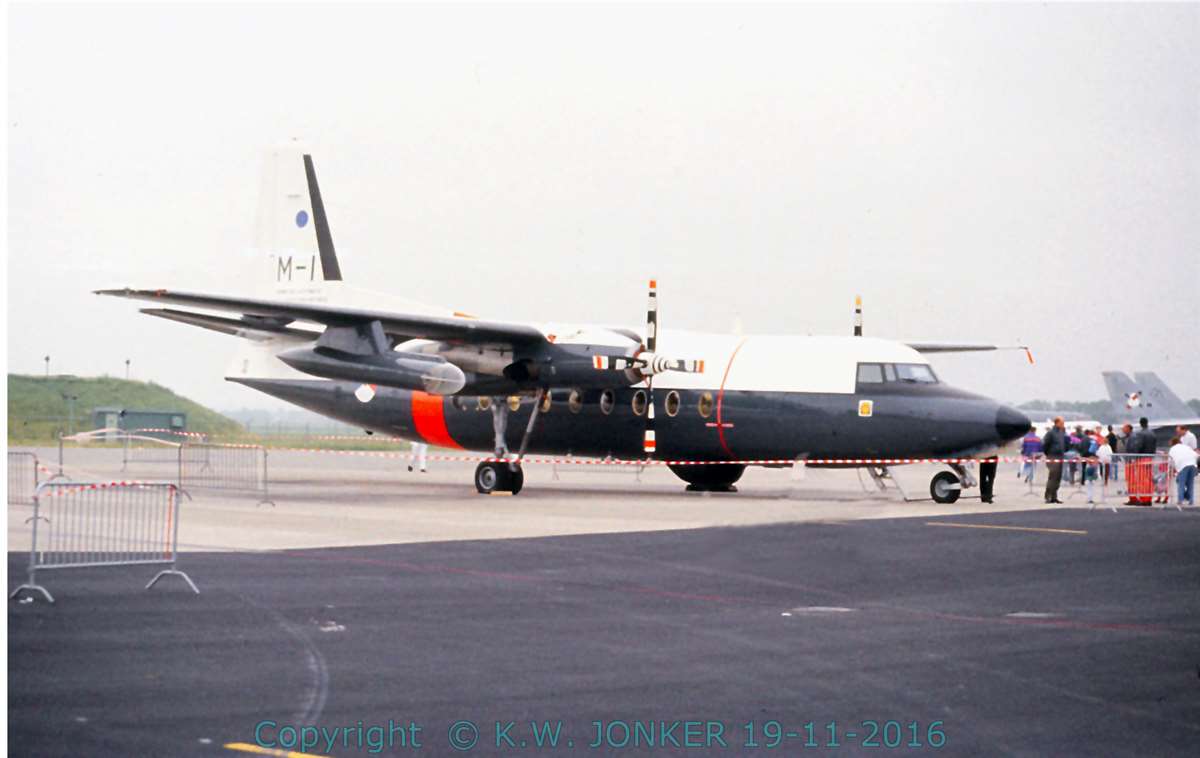
Fokker F.27M, M-1, photographed during airshow 75yeaars RNlNAS, June 1992 at air station Valkenburg.
On June 30, 1980 it was decided to purchase two examples of this type, later a number of extra aircraft would possibly be purchased.
The F-27M had good positioning system, Liton radar and life-saving equipment such as lifeboats and also a large flight endurance of up to eleven hours (with external fuel tanks).
Furthermore, the Maritime had more powerful engines than the original version, i.e. 2320 hp each, over 720 hp more, making the take-off weight increased from 35000 to 45000 pounds.
On September 30, 1981 the first Maritime, registered M-1 was transferred to Schiphol. On November 9, 1981 the aircraft departed from Soesterberg to the West Indies and flew via the Azores, Canada, Bermuda and Puerto Rico , to the Dr. A. Plesman Airport Willemstad, where it arrived on November 13, 1981.
The M-2 departed on March 8, 1982 from Soesterberg and flew via Las Palmas, Senegal, Brazil and French Guiana. Due to a leaking fuel tank in Dakar, Senegal arrived the aircraft arrived just on March 18, 1982 at Hato.
After two weeks corrosion problems occurred. This was caused because most flight s were at low level above sea and also the aircraft were parked day and night in the open air on the platform, which was about 125 m from open sea. [the existing hangars were too small for the F-27] Furthermore, the trade wind was almost permanently present with lots of sand, high humidity and lots of salt.
All maintenance must take place in the open air and in addition, there were insufficient resources to achieve adequate control of the corrosion. After a patrol flight the pilots were usually looking for a cloud and flew through it, to to rinse the aircraft slightly.
After much discussions about the costs the two old hangars were demolished in August 1985 and shortly thereafter began the construction of a new larger hangar, which was officially opened in June 1986.
in February 1986 despite these measures both aircraft were even even temporarily held to the ground as a result of the corrosion problems.
In September 1992 the right pylon tank with the hardly used searchlight of the M-1, was removed and replaced with a new tank without searchlight.
An periodic examination showed that three out of four tanks were corroded in such a way they could be used any more.
Because the tanks were not immediately necessary, they were not replaced but completely omitted.
| Serial | Constr. nr. | Date in service | Date out of service | Notes |
|---|---|---|---|---|
| Fokker F.27 Friendship Mk.100 | ||||
| C-1 | 10152 | 23-08-1960 | 24-9-1996 | PE-CAA 28-seater; First camouflaged F.27 in August 1971. Test flight with registration PH-FBR September 1994 sprayed in grey white colour scheme (VIP-scheme). September 24, 1996 withdrawn from use and stored at air base Woensdrecht. December 1997 sold as ZS-OEH. |
| C-2 | 10149 | 07-07-1960 | 26-9-1996 | Test flight with registration PH-FBO; PE-CAB 32-seater November 1994 sprayed in grey white scheme (VIP scheme). September 1996: last F.27 check at Fokker-Woensdrecht. September 25, 1996 last official Fokker F.27 flight of RNlAF. September 26, 1996 withdrawn from use at air base Woensdrecht and stored. |
| C-3 | 10150 | 06-08-1960 | 15-5-1996 | Test flight with registration PH-FBP; PE-CAC 32-seater; Equipped with a belly radome in October 1974 for ECM training. May 15, 1996 withdrawn from use and stored at air base Woensdrecht |
| Fokker F.27 Troopship Mk.300 | ||||
| C-4 | 10154 | 06-10-1960 | 04-09-1996 | Test flight with registration PH-FBS; PE-CAD. In 1992 white UN scheme. Between May 20, 1992 and November 18, 1992 to Cambodia for UN mission. September 1996 IFOR markings applied. September 3, 1996 to air base Woensdrecht and withdrawn from use on September 4, 1996. December 1997 sold as ZS-OEJ/Luft Afrique, later TR-LGH/National Airways Gabon |
| C-5 | 10155 | 30-06-1960 | 31-07-1996 | Test flight with registration PH-FBT; PE-CAE; Modified as navigation trainer to replace the Beech TC-45J, November 1973. April 1988 KLu 75 markings applied and used for F.27 display. January 1994 grey colour scheme in original pattern, but with same colours as used on the F-16. [Officially shown on February 10, 1994]. Between March 30, 1996 and July 1996 to 336 squadron for navigation training. Withdrawn form use on July 31, 1996. December 1997 sold as ZS-OEI/Luft Afrique, later 5Y-BRN/Air Express |
| C-6 | 10156 | 07-12-1960 | 28-03-1996 | Test flight with registration PH-FBU ;PE-CAF; Modified as navigation trainer to replace the Beech TC-45J, November 1973. In 1992 wit scheme for UN mission Between May 20, 1992 and November 18, 1992 to Cambodia for UN mission. March 1996 IFOR markings applied. Withdrawn from use March 28, 1996. September 1997 sold as C-GWXD/Western Express Airlines, later J5-GBU,J5-GIA/Air Bissau |
| C-7 | 10157 | 29-12-1960 | 13-06-1996 | Test flight with registration PH-FBV; PE-CAG; Modified as navigation trainer to replace the Beech TC-45J, November 1973. Withdrawn from use June 13, 1996 and stored at air base Woensdrecht. In 2000 sold to Fa. Valitrade 151 Ltd, South Africa for spare parts. Oktober 2002 Fuselage scrapped at air base Woensdrecht. Remains to air base Eindhoven for fire practice. |
| C-8 | 10158 | 28-12-1960 | 01-08-1996 | Test flight with registration PH-FBW, PE-CAH; PH-FSC; Between June 10, 1966 and November 2, 1966 equipped with a F-104G nose, for training purposes; nick-named 'Flipper'. Damage during thunderstorm on May 7, 1968 during a flight from Ypenburg to Twente; The nose was damaged and the cone fell off near Houten. Repaired and equipped with standard F.27 nose. Juli 1992 white colour scheme because of UN Missions. May 1993 display scheme applied. Withdrawn from use August 1996. Preserved and used for instructional purposes at air base Eindhoven |
| C-9 | 10159 | 04-01-1961 | 27-10-1995 | Test flight with registration PH-FBX; PE-CAI; Temporarily as PH-KFA, "jan Dellaert" on loan to NLM in May 1966; returned to KLu May 1972. Withdrawn from use October 27 1995 and in March 1996 stored at air base Woensdrecht. In 2000 sold to Fa. Valitrade 151 Ltd, South Africa for spare parts. October 2002 fuselage scrapped. |
| C-10 | 10160 | 07-01-1961 | 15-10-1993 | Test flight with registration PH-FBY; PE-CAJ August 1992 white colour scheme for UN missions. May 1993 display scheme applied. October 15, 1993 withdrawn from use. To air force museum at Soesterberg in 1994. |
| C-11 | 10161 | 10-02-1961 | 04-06-1996 | Test flight with registration PH-FBZ; PE-CAK; Temporarily PH-KFB, "Willem Versteegh" on loan to NLM in May 1966; returned to KLu May 1972. In 1992 white colour scheme because of UN missions. Between May 20, 1992 and November 18, 1992 to Cambodia for UN mission. May 1995 UN markings applied. Withdrawn from use June 4, 1996 and stored at air base Woensdrecht. December 1997 sold as ZS-OEK |
| C-12 | 10162 | 28-04-1961 | 18-08-1994 | Test flight with registration PH-FCA; PE-CAL; Gate guard at air base Eindhoven (painted as C-8) August 18, 1994 withdrawn from use and stored at air base Woensdrecht. Moved to Air base Eindhoven for instructional purposes. Sprayed as C-8 in display scheme and shown as Gate Guard (as replacement of the real C-8) [C-12 was completely stripped and not useful as instructional air frame, whereas C-8 was complete). |
| Fokker F.27 Maritime | ||||
| M-1 | 10612 | 30-09-1981 | 07-07-2000 | Test flight with registration PH-EXC. September 30, 1981 handed over to RNlAF and on October 1, 1981 flown to air base Soesterberg. Flown to Hato, Curaçao on November 19, 1981. Between November 15, 1996 and January 24, 1997 modified to NAV/COM-trainer at Woensdrecht. July 7, 2000 withdrawn from use and stored at air base Eindhoven. Sold as 3C-SQB |
| M-2 | 10622 | 25-02-1982 | 11-04-2000 | Test flight with registration PH-EXD. Handed over to RNlAF on March 3, 1982, 336 squadron. March 8, 1982 flown to Hato, Curacao. between January 30, 1987 and March 26, 1987 major maintenance (the Netherlands). Between October 4, 1996 and November 5, 1996 modified to NAV/COM-trainer at Woensdrecht. In April 11, 2000 withdrawn from use and stored at air base Eindhoven. Sold as 3C-SQC. |
1/72nd Scale
Kits
- Airfix
- Kit 583/05003-4: Older release of the Fokker F.27. Recently re-released with additional parts as radar nose .
- Kit 05003:
- ESCI
- Kit 9112: A model of a Fokker F.27 Mk 400 Troopship
- Kit 9111: A model of a Fokker F.27 Mk 400 Friendship
- Kit 9113: A model of a Fokker F.27 Mk 400 MPA

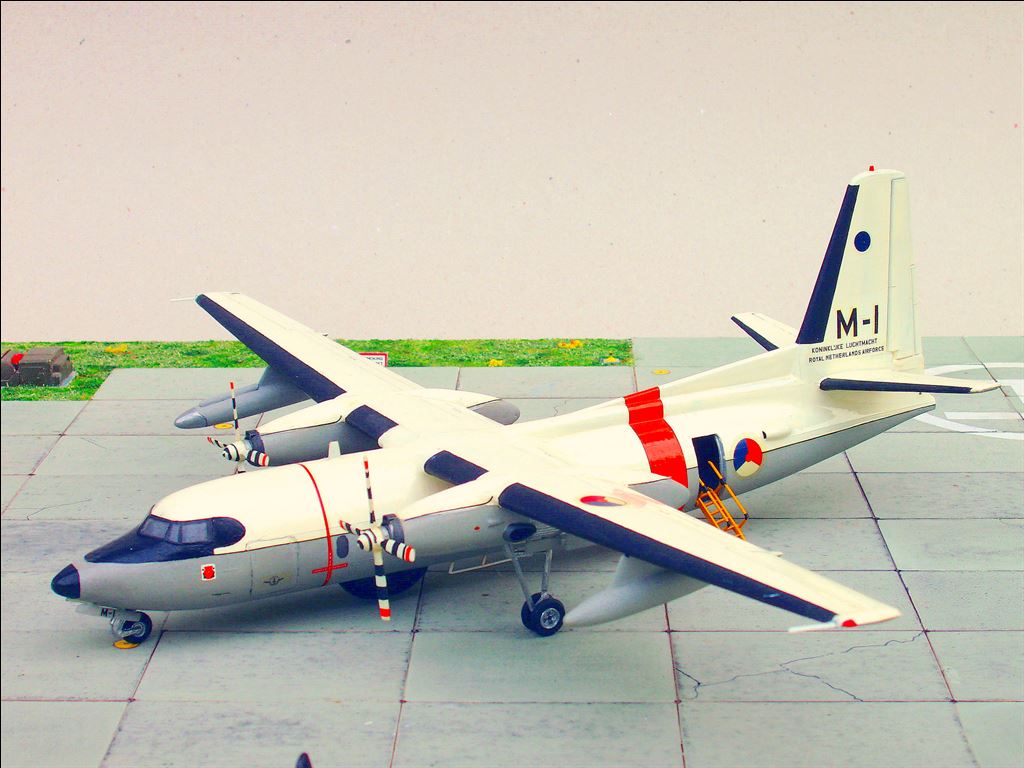
Modelling add-on
- Master Model
- Set XX: a resin set engines and wings meant for ESCi kit
- Set XX: A set resin engines, wings and other parts for a Fokker F.27M (based on ESCI kit)
Decals
- Dutch Decal
- Set 72031: Decals with squadron badges such as 334 squadron
- Set 72019: Decal set for Fokker F.27 MPA M-1 and M-2
- Set 72016: Decal set for several aircraft such as Fokker F.27 C-5 with KLu 75 markings.
1/48th Scale
Kits
- --
- Kit --: --
Modelling add-on
- --
- Set --: --
Decals
- --
- Set --: --
Upon delivery, the Fokker F.27s were in the same colour scheme as their predecessor, the Dakota: top of the fuselage white, light gray undersides and orange day glo panels.
Because of the NATO Physical Protection Programme, the aircraft were camouflaged from 1971. The C-1 was the first F.27 which was camouflaged.
Furthermore, a some of the Fokkers were modified for the 'CSR (Additional Military Flying Training) [for the Netherlands Navy]; the C-5, C-6 and C-7 were modified as a navigation trainer and C-3 was converted into ECM trainer.
Fokker F.27M Troopship and Fokker F.27 Friendship.
| Scheme | Colour name | FS number | BS-number | Humbrol | XtraColor | Vallejo Model Color | Vallejo Model Air | Hataka | |
|---|---|---|---|---|---|---|---|---|---|
| Standard #1 | Undersides | Light Grey | ~6440 | 129 | X137 | 70.986 | 71.121 | ~048 | |
| Upper surfaces | White | ~7875 | 9010 | 130 | 70.820? | 71.279 | ~049 | ||
| Standard #3 | Upper surfaces | Olive green | 6014 | X251 | - | - | ~193 | ||
| Dark Grey | 7012 | 79 | 70.869 | 71.123 | ~192 | ||||
| Undersides | Haze Grey | ~6320 | 7001 | 128 | X135 | 70.990 | 71.275 | ~189 | |
| UN-scheme: C-2; C-4 1967; C-7 in 1972-1973 an C-4; C-11 1993 | |||||||||
Overall |
White | ~7875 | 9010 | 130 | 70.820? | 71.279 | ~049 | ||
| C-1 and C-2 from 1994 and on | |||||||||
| Standard #3 | Upper surfaces | White | ~7875 | 9010 | 130 | 70.820? | 71.279 | ~049 | |
| Undersides | Grey | ~6440 | 129 | X137 | 70.986 | 71.121 | ~048 | ||
| C-5 from 1994 | |||||||||
| Standard #4 | Upper surfaces | Grak Grey | ~6118 | 125 | X130 | 70.836 | 71.053 | ~031 | |
| Grey | ~6270 | 126 | X133 | 70.870 | 71.275 | ~054 | |||
| Undersides | Light Grey | ~6375 | 127 | X136 | 70.990 | 71.046 | ~037 | ||
Fokker F.27 Mk.100 Friendship
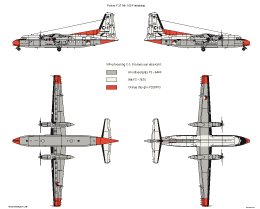
Fokker F.27 Mk.300 Troopship
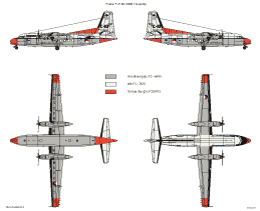
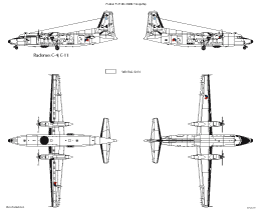
Fokker F.27 Maritime.
| Scheme | Colour name | FS number | BS-number | Humbrol | XtraColor | Vallejo Model Color | Vallejo Model Air | Hataka | |
|---|---|---|---|---|---|---|---|---|---|
| Delivery scheme M-1 | Upper surfaces | White | ~7875 | 9010 | 130 | 70.820? | 71.279 | ~049 | |
| Undersides | Grey | ~6270 | X133 | 70.870 | 71.275 | ~054 | |||
| Day Glo surfaces (ANA 633) | 28913 | 70.910 | |||||||
| Delivery scheme M-2 after overhaul also applied to M-1 | Upper surfaces | White | ~7875 | 9010 | 130 | 70.820? | 71.279 | ~049 | |
| Undersides | Grey | 36099 | 140 | X131 | 70.867 | 71.053 | ~235 | ||
| Day Glo surfaces | 3026 | 209 | 70.733? | ||||||
Check www.paint4models.com for an extensive conversion table with lots of colour and paint systems.
Fokker F.27 Maritime
Literature.
| AVIA; 34e jaargang nummer 3: Het gaat SPOKEN bij de Luchtmacht | Dick van der Aa | Pag. 94 - 95 | 1975 | Uitgevers Wyt, Rotterdam |
| Nederlandse Militaire Luchtvaart in Beeld. deel 2 | Hugo Hooftman | Pag. 126 - 129 | 1978 | Uitgever: Europese Bibliotheek, Zaltbommel |
| Dutch Military Aviation 1945-1978 | Paul A. Jackson | Pag. 68; 82 | 1978 | Uitgever: Midland Countries Publications, Leicester |
| Modelbouw In Plastic jaargang 7, nummer 4: Fokker F-27, deel 1. | Max Schep | Pag. 122 - 127 | 1978 | Uitgever: I.P.M.S. Nederland, Nederland |
| Modelbouw In Plastic jaargang 8, nummer 1: Fokker F-27, deel 2 | Max Schep | Pag. 4 - 20 | 1979 | Uitgever: I.P.M.S. Nederland, Nederland |
| AVIA: 38e jaargang nummer 9: Fokker's maritieme Friendship: de F-27 MPA | Bart van der Klaauw | Pag. 341 - 344 | 1979 | Uitgevers Wyt, Rotterdam |
| Fokker-vliegtuigen voor de Militaire Luchtvaart | Pag. 30 | 1982 | ||
| De Nederlandse Vliegtuigen: Alle vliegtuigen ooit in Nederland ontworpen en gebouwd | Theo Wesselink & Thijs Postma | Pag. 133 - 137 | 1982 | Uitgever: Romen Luchtvaart, Haarlem |
| AVIA: 41e jaargang nummer 5: De veelzijdige F-27 Maritime; straks misschien ook in Nederland? | Pag. 174 - 175 | 1982 | Uitgevers Wyt, Rotterdam | |
| Squadrons van de Koninklijke Luchtmacht | Willem Helfferich | Pag. 126; 131 - 132; 135 | 1983 | Uitgever: Unieboek b.v., Houten |
| Koninklijke Luchtmacht 70 | C. van der Velden & E. Ragas | Pag. 4 - 5; 7 | 1983 | Uitgever: AMBooks, Bromley, Kent |
| Luchtvaartwereld; 2e jaargang nummer 3: Militaire varianten van de Fokker F-27 | Druenen, Rene van | Pag. 109 - 111 | 1985 | Uitgeverij Ten Brink, Meppel |
| Luchtvaartwereld; 4e jaargang nummer 6: Werkpaard en vredesduif | Theo Wesselink | Pag. 181 - 185 | 1987 | Uitgeverij Ten Brink, Meppel |
| KLu Vliegtuigen: De vliegtuigen van de Koninklijke Luchtmacht vanaf 1913 | Wim Schoenmaker & Thijs Postma | Pag. 133 | 1987 | Uitgeverij De Alk, Alkmaar |
| Luchtvaartwereld; 5e jaargang nummer 12: De Koninklijke Luchtmacht overzee. | Herman Sixma & Theo van Geffen | Pag. 342 - 345 | 1988 | Uitgeverij Ten Brink, Meppel |
| Luchtvaartwereld; 5e jaargang nummer 7/8: De werkpaarden van de Koninklijke Luchtmacht | Herman Sixma & Theo van Geffen | Pag. 207 - 211 | 1988 | Uitgeverij Ten Brink, Meppel |
| Modelbouw in Plastic jaargang 22, nummer 4: Fokker F-27 | Meindert de Vreeze & Damen Bas | Pag. 78 - 98 | 1993 | Uitgever: I.P.M.S. Nederland, Nederland |
| Squadrons van de Koninklijke Luchtmacht (derde herzien druk) | Willem Helfferich | Pag. 36 - | 1994 | Uitgevers Wyt, Rotterdam |
| Camouflage en Kentekens | J.Greuter e.a. | 1997 | Bonneville – Bergen (NH) | |
| Luchtvaart; 16e jaargang nummer 6: KLu 334 squadron 55 jaar | Wendstedt, Bart | Pag. 22 - 25 | 1999 | Uitgeverij Ten Brink, Meppel |
Websites.
Special thanks to mr P. Burger for information about the F.27 MPA, mr K. Oostlander for photos of the Fokker F.27
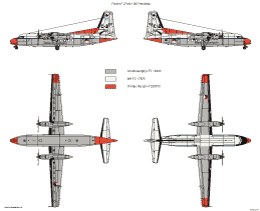
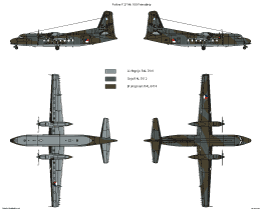
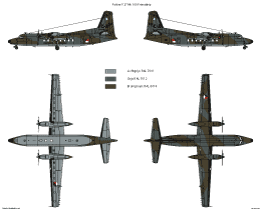
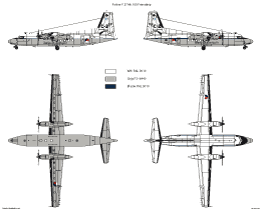

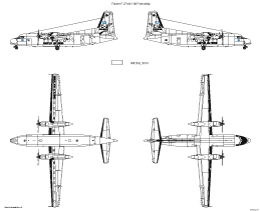
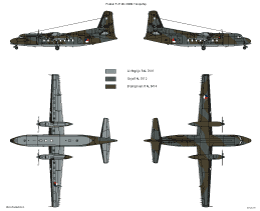
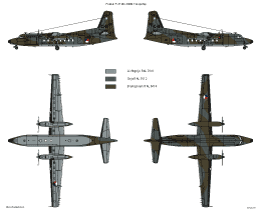

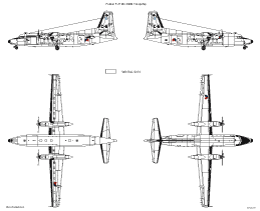
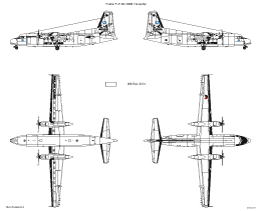
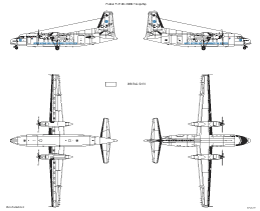
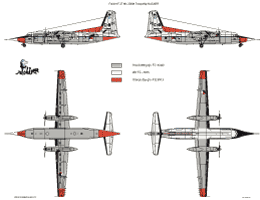

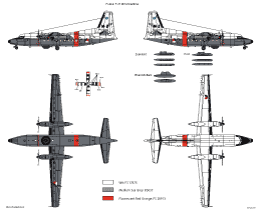
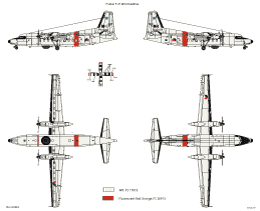
 Nederlands (nl-NL)
Nederlands (nl-NL)  English (United Kingdom)
English (United Kingdom)